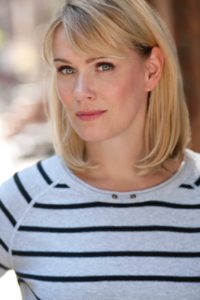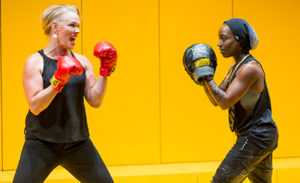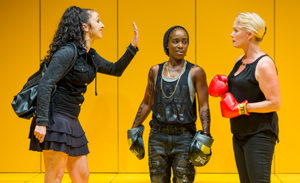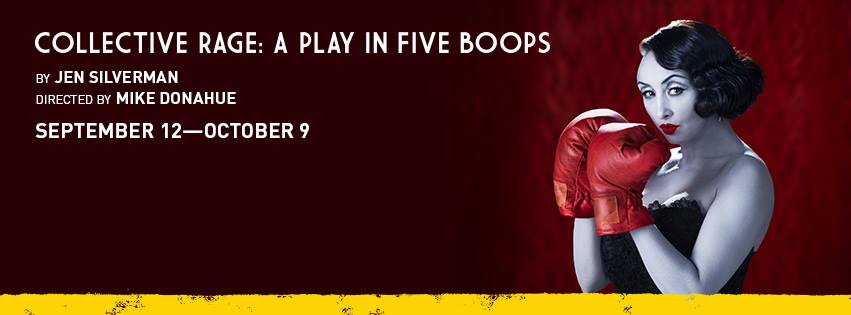Boop-boop-be-BLAM! Woolly Mammoth Theatre Company is opening their 2016/2017 season with an honest-to-God firecracker of a play. Delivering the world premiere of Jen Silverman’s Collective Rage: A Play in Five Boops, Woolly sets the bar high for the rest of the conversationally loaded season with this thunderclap of a theatrical experience. In a TheatreBloom exclusive interview we sit down with Beth Hylton, playing Betty Boop 1, and pick her brain on the whole “Boop Experience.”
Hi, Beth! Thanks for taking a few minutes out of your busy schedule to chat with us! If you could just give the readers a brief introduction of what you’re doing in this show and what you’ve done in the area that they might recognize of your work, we’ll get started.

Beth Hylton: I’m playing Betty Boop 1. All of the characters in this play are Betty Boops, and I’m the first Boop that the audience meets in the play. In terms of work around the area I’m a company member up at Everyman (Everyman Theatre) in Baltimore so I’ve been in several things there over the past few years. I just did Blanche in Streetcar (Tennessee Williams’ A Streetcar Named Desire) there last season, and I played one of the Chippies in the bar in Salesman (Arthur Miller’s Death of a Salesman.) I was also in Outside Mullingar this past season. In previous seasons I was in The Understudy and a few other shows. I’ve worked at Round House in DC over the past couple of years as well as Rep Stage. That’s where I’ve been for the most part.
This is not your first Jen Silverman play, is that right?
Beth: Actually, this is my first Jen Silverman play, but as soon as this closes, well a week after it opens I begin rehearsals for another Jen Silverman play up at Everyman called The Roommate. It’s a two-person play that was just at the Humani Festival. I believe we are the first regional production of the play after it premiered at The Actors Theatre of Louisville, where it was a big, big hit. I’m excited to be working with Deborah Hazlet for that one. She and I have played sisters, and enemies and all kinds of really cool stuff together over the years. She and I were actually together a few years ago here at Woolly for Branden Jacobs-Jenkins’ Appropriate with Leisl Tommy directing it, we played enemies in that. This is going to be a really fun thing to do with her, she’s one of my favorite collaborators to work with so that is going to be really exciting.
What is it about Jen Silverman’s work that keeps drawing you into these projects?
Beth: It’s really terrific because it’s very unusual that you do two new plays, and by a woman playwright no less, in the same season and then back to back on top of that. It’s very telling of Jen’s work as a playwright. She’s really an unusual voice. The two plays are very, very different. I’m not even sure that there’s anything that you could find between the two that you could say makes them the same. Her writing is the same in terms of how she lays it on the page but the audience isn’t going to know that. It’s huge for the actors in terms of how the plot functions and how the characters work but the audience won’t know that. The only thing that they have in common is that she writes so that the actor understands how to play a part in a really clear way. She’s very much an actor’s writer. The plays couldn’t be more different.
Collective Rage is a really huge comedy. It’s not exactly a realistic world. The things that happen in the world are very truthful, but it’s not realism. The Roommate is realism. It’s set in a kitchen and you follow the story of these two women in Iowa. It’s very straight forward and narrative. It’s easy to follow, the world is a real one. They’re not very similar in terms of how their worlds are built.
Collective Rage: A Play in Five Boops, you just mentioned all the characters are named Betty Boop, what was your working familiarity with the cultural icon of Betty Boop before you came into the project?
Beth: It wasn’t a lot. I knew who Betty Boop was and I had seen the cartoons, but I never really thought about it in terms of how she was presented. Of course she’s drawn by a man. She’s always escaping near-calamity. Jen said she was home with the flu or something like that and she was watching cartoons and she remembered there was a cartoon where Betty Boop almost got raped. She runs away and the tagline of the whole thing was “Boop-boop-boo, glad I got away from that!” And it was femininity through the lens of the male gaze. I think the hyper-sexuality of Betty Boop is what everyone ends up focusing on. We never thought about it or focused on it when we were growing up, but when you watch it again now that you’re grown up it’s sort of, “Oh, wow. That’s crazy.” Jen just expanded that thought process into the play, asking the question of what is the outline for female contemporary identity? What is that outline and how can you draw a through-line from Betty Boop to now? That’s what we’ve done with this play and it’s really kind of cool.
What is it like doing a show where all five characters share the same name, but are obviously on very different paths, but then intersect?

Beth: It’s great. There are lots of great jokes because all five women are named Betty. There is a lot of comedy in there with that. We’re all very, very different. The notion that we’re all named Betty and that we’re all kind of Betty Boop quickly went away when we really started up. Between the costume work and Mike (Director Mike Donahue) who is an amazing director, and Kelsey (Costume Designer Kelsey Hunt) who is brilliant, very quickly we were able to separate them. We were able to look at the outline and see what the Boop-outline that each of us individually had within the story. We figured out how to inhabit that and in doing so the “Boop-ness” or the “Betty-ness” went away as we leaned in more heavily to those outlines of the characters where we were on the spectrum between one and five.
What is it that you are bringing to your Betty and that your Betty is bringing to you in this production?
Beth: It’s really funny, I have to say honestly, I was naturally blonde all my life. But then I dyed my hair brown for about ten years as an actor. And suddenly I’m blonde again now, because I’m older and I’ve got gray hair and it’s easier to upkeep blonde. What has been really interesting as inhabiting this character as a blonde. Betty Boop 1 is an uptight, rich, white, Upper East Side kind of lady. I come from a working a class family, my dad’s a cow farmer and my mom worked in the cafeteria of my junior high school. But my perception of myself is not along those class lines as far as how I’m perceived in the world. It’s been interesting going back to blonde because of what it then says about how the world views me, even though who I am inside is very different from how I know I’m perceived. That has been a lot of fun for me. When I was 28 and 29, being uptight and blonde or being bimbo and blonde was very limited in terms of my casting but now it’s fun. It’s just a different color that I get to bring. These characters, they all transform, they all reveal themselves, they all open up. The surprise of it is just so much fun to lean into. I think a lot of things that meant different things when I was younger are now just a lot of fun and I get to play with them and I get to play that perception of who I am versus who people think I am and that has just been a delight to do.
What would you say has been the biggest challenge for you in this play of Boops?
Beth: I haven’t really had any challenges, to be honest. Of course there’s always the challenge of figuring out what the world is and how to tell the story. There’s a lot of direct address in the play. Most of the Boops at one point or another speak directly to the audience. Why they’re speaking and to what purpose and how that impacts the story and where the audience then goes after you’ve spoken to them, I think that’s a challenge. I think that’s the biggest ones in terms of figuring out the story, where you are in the story and how to further where you are in the story. Mike has been such an amazing director. You can imagine five women coming together for this project, and we did have an extra week because of a grant that Woolly has, which was wonderful because it meant an extra week of table work, which is such a gift for a new play.
But imagine five people coming together in that little bit of time, trying to put together this story of this brand new play, and what kind of pressure that creates. Things could have been crazy. But it was such a dream to work with Mike. He’s a brilliant director, he’s very clear and he’s very articulate. He’s very clear about his vision and very generous in the room. All of the other actors in the room are very genuine and we genuinely love each other and we’re having a very good time. It’s funny, Howard (Artistic Director Howard Shalwitz) and I were walking out after our final dress rehearsal and I said “it feels like such an ensemble piece, which is kind of the opposite of how it is in the page because it’s really written to look like individualism.” I think that speaks so well to what Mike has done and what Jen has done and what this group of artists have brought into the room. Everybody gets their piece of pie in this show. It’s a lot of fun to do.
What are you hoping that audiences are going to take away from seeing Collective Rage?
Beth: It’s very in your face about— well not about sexuality but about how woman identify with themselves. There are words in this plays, and I’m sure you can’t put these in print, but we use the “P*word” and the “C*word”, a lot of words that have negative connotations when we use them out in the world. We kind of take some of these words back in terms of appropriation. And it’s a crazy comedy. It’s really just about liberating our mind as a society from the roles that we are assigned.
I sort of want to track back to one of your previous questions here. One of the things I think Jen does, the thing that her plays do have in common— at least these two, The Roommate and Collective Rage— there are these women who are pushed to the edge of their experience, into the outline of who they believe they are to the point where they have to expand that outline to include a bigger section of themselves. I hope that people take away the notion that they can extend their own outline. These are just outlines that have been prescribed to us. We, if we choose, have the opportunity to change, to shift, or to move. It just comes down to realizing that these words— these words that mean nothing more than female genitalia— have come to mean negative things.

And if nothing else, I hope you walk away saying “Wow, that’s kind of fucked up.” Look at these words. If you’re ballsy it means you’re brave. But if you’re pussy, it means you’re scared. Jen desensitizes you to the word; you hear it, you hear it, you hear it, and you hear it. And then you get to hear it in a new way. If nothing else I hope that people walk away with the idea that “I can just change my mind.” That’s what Jen’s plays do, they give you the opportunity to realize that you can just change your mind.
What would you say working on this project has taught you about yourself?
Beth: The last thing I did was Streetcar, which was definitely not a comedy. I love language plays; I love plays with meaty language that are smart with language. Tennessee Williams and Jen Silverman, of course they’re very different playwrights, but they give you very precise language. Of course, Blanche talks like five million times, but it’s all to a purpose. All the words mean something. Each word is chosen for a reason. That’s such a delight for an actor to get to do. With this show, because there is so much direct address to the audience, and coming directly out of Streetcar where there is no direct address, and here I come out and start immediately addressing the audience— it’s taught me just to remember the muscularity of comedy writing and to lean into that. There’s a real in-your-face-ness to it that I haven’t done in a long time. With every show you do you hope to come out a better performer than you were coming into it. It’s just been really cool to discover that my instrument is stronger and more aggressive. That has been really exciting and exhilarating to sit on the edge of that and wonder how much further can it go? What more can I do? How can I push this? What is this avenue? It’s really cool to dig into that and lean forward into that. This play is a very— and I don’t want to give anything away— but you’ll see that from the very set up of the show, there’s an aggression in this world. There is a lean-forwardness and an aggression in this world that we step into!
Why do you want people to come and see Collective Rage?
Beth: Jen is going to be famous. Jen is going to be very, very famous. People are going to be studying her in college classes pretty soon if they’re not already. Her voice is so unique and she’s got a lot of really cool stuff to say and I think it’s very important for right now with what she does have to say. I think it’s very cool that local audiences have this opportunity to see a world premiere of a play by this playwright who is on her way to becoming one of the most important voices in American theatre. I think you have an opportunity to come and see a brand new work before it heads wherever it’s going to head. It’s so unique. And it’s rare. Plus, we’re all local— we have one actor in the cast from New York and she’s great— but the rest of us are all local, we’re all people that you know. There is so much incredible transformation on the stage; the whole play is about the transformative power of the theatre. Then you see these actors who you know transforming into very different things than what most audiences have ever seen them do.
Collective Rage: A Play in Five Boops plays through October 9, 2016 at Woolly Mammoth Theatre Company— 641 D Street NW in the Penn Quarter District of Washington DC. For tickets call the box office at (202) 393-3939 or purchase them online.
To read the review of Collective Rage: A Play in Five Boops, click here.

